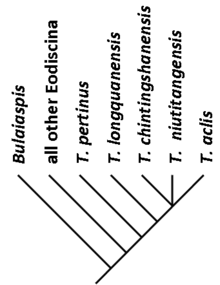Tsunyidiscus
| Tsunyidiscus Temporal range: Late Atdabanian | |
|---|---|
 | |
| linedrawing of Tsunyidiscus niutitangensis | |
| Scientific classification | |
| Kingdom: | Animalia |
| Phylum: | Arthropoda |
| Class: | Trilobita |
| Order: | Agnostida |
| Suborder: | Eodiscina |
| Family: | Tsunyidiscidae Zhang, 1980 |
| Genus: | Tsunyidiscus W. Chang, 1966 |
| Species | |
And see text | |
Tsunyidiscus is a genus of eodiscinid agnostid trilobites. Tsunyidiscus occurs near the end of the Lower Cambrian, during the late Atdabanian stage period and some collections suggest it may have survived into the Botomian. They are very small (up to 7mm), have eyes, and equal sized head and tail shields, with a narrow dome-shaped glabella and a narrow bullet-shape pygidial axis. It has a thorax of three segments. Tsunyidiscus is the only genus currently attributed to the family Tsunyidiscidae.[1]
Description
Like other Agnostida the body of Tsunyidiscus is diminutive, the headshield (or cephalon) and tailshield (or pygidium) are of approximately same size, with 3 thoracic segments in-between, each consisting of a horizontal inner portion that abruptly passes into an inclined outer portion (fulcrate). The cephalon has a deeply parabolic outline and maximum width (tr.) usually anterior to genal angle. Glabella extremely narrow, lateral glabellar furrows usually obscure, with rounded and expanded frontal glabellar lobe. The most backward lobe of the glabella (called occipital ring or LO) at least as long as the lobe in front of it (L1), and is usually expanded laterally, may bear sharp, posteriorly directed spine. Long, curved posterior fixigenal spine may be present. The furrow between those two lobes (SO) is transverse and uninterrupted. The facial sutures are proparian. The free cheeks or (librigena) are ½× as long as the cephalon. The pygidium has a narrow, multisegmented axis (with five, six or more segments). The thorax and pygidial axis segments may carry nodes.[1][2]
Species and distribution
- Tsunyidiscus aclis (Zhou, 1975)
- = Emeidiscus planilimbatus, Mianxiandiscus badaowanensis, M. emeiensis, M. gaoqiaoensis, M. jinningensis, M. sichuanensis
- Collected in the Lower Cambrian of China (Atdabanian: Jinning, 24.7° N, 102.7° E[3] and Maotianshan 24.0°N, 102.0°E,[4] Yuanshan Formation, Yunnan).
- Tsunyidiscus acutus (Sun, 1983)
- Present in the Lower Cambrian of China (Atdabanian, Shuijingtuo Formation, Yichang and Zgui, Yangtze Gorge Area, Hubei, 111°E, 30.5°N)[2]
- Tsunyidiscus armatus (Zhang & Zhu, 1980)
- Occurs in the Lower Cambrian of China (Atdabanian: Weng'an, Longshancun Section, Niutitang Formation, Guizhou, 27.1°N, 107.5°E)[3]
- Tsunyidiscus chintingshanensis (Lu, 1942)
- = T. kaiyangensis, Eodiscus chintingshanensis, Guizhoudiscus chintingshanensis, G. kaiyangensis, H. chintingshanensis
- Occurs in the Lower Cambrian of China (Zhongxin).[5]
- Tsunyidiscus limbanodus Qian in Zhang et al., 1980
- Tsunyidiscus longquanensis (Zhang and Zhu in Zhang et al., 1980)
- = Shizhudiscus longquanensis
- Tsunyidiscus niutitangensis (Chang, 1964)
- = Hebediscus niutitangensis
- Known from the Lower Cambrian of China (Atdabanian: Jinning, 24.7° N, 102.7° E[3] and Malong, 25.4° N, 103.4° E,[6] Yuanshan Formation, Yunnan; Zhijin, Gezhongwu Section,[3] and Weng'an, Longshancun Section, Niutitang Formation, GuiZhou, 26.7°N, 105.8°E.
- Tsunyidiscus pengshuiensis Zhang & Clarkson, 2012 was extracted from the Lower Cambrian of China (Qiongzhusi Formation).[7]
- Tsunyidiscus pertenus Lin et al., 2004
- = T. orientalis, Hebediscus orientalis, Hupeidiscus orientalis
- Found in the Lower Cambrian of China (Atdabanian: Huanglian Member, Jiumenchong Formation, 28.2°N, 109.2°E, Taijiang, Wuhe Member, Jiumenchong and Bianmachong Formations, 26.7° N, 108.3° E);[3] Botomian: Weng'an, Longshancun Section, Mingxinsi Formation, Guizhou, 27.1°N, 107.5°E;[3] Atdabanian: Pangwangcun Member, Huangboling Formation, Anhui, 30.1°N, 117.0°E[3]
- Tsunyidiscus yanjiazhiensis S. Zang et al. in Yin and Li, 1978
- Tsunyidiscus sp.
- Present in the Lower Cambrian of China (Atdabanian: Shuijingtuo Formation, Yangtze Gorge, Hubei, 30.8° N, 111.3° E).[8]
Taxonomy

Ancestors
Tsunyidiscus is the oldest known eodiscoid. The glabella of Tsunyidiscus is extremely similar to that of Dipharus clarki, and distinct from all other eodiscoids. D. clarki is thought to represent an immature stage of the redlichioid Bulaiaspis rather than an eodiscoid. This is because of the dominant palpebroocular ridges, extremely long librigenae, and free pleural tips on the pygidium of variable numbers of segments. In short: Tsunyidiscus is thought to have developed through paedomorphosis from Bulaiaspis.[1]
Descendants
Three lineages are thought to have evolved from Tsunyidiscus. First the Hebediscidae, that themselves gave rise to the Weymouthiidae, which contain Tannudiscus, the probable ancestor of the Agnostina. Second the Yukoniidae, who sprouted the Eodiscidae. And finally the Calodiscidae.[1]
References
- 1 2 3 4 Whittington, H. B. et al. Part O, Treatise on Invertebrate Paleontology. Revised, Volume 1 – Trilobita – Introduction, Order Agnostida, Order Redlichiida. 1997
- 1 2 Dai, T.; Zhan, X. (2011). "Ontogeny of the eodiscoid trilobite Tsunydiscus acutus from the Lower Cambrian of South China". Palaeontology. 54 (6): 1279–1288. doi:10.1111/j.1475-4983.2011.01102.x. ISSN 0031-0239.
- 1 2 3 4 5 6 7 A. Yang, M. Zhu, J. Zhang and G. Li. 2003. Early Cambrian eodiscoid trilobites of the Yangtze Platform and their stratigraphic implications. Progress in Natural Science 13(11):861-866 |cited in=PBDB
- ↑ J. Yugan, H. Xianguang, and W. Huayu. 1993. Lower Cambrian pediculate lingulids from Yunnan, China. Journal of Paleontology 67(5):788-798|cited in=PBDB
- ↑ Paleobiology Database. "†Tsunyidiscus chintingshanensis Lu 1942 (trilobite)". Retrieved 25 November 2012.
- ↑ M. Steiner, M. Zhu, Y. Zhao and B.-D. Erdtmann. 2005. Lower Cambrian Burgess Shale-type fossil associations of South China. Palaeogeography, Palaeoclimatology, Palaeoecology 220:129-152|cited in=PBDB
- ↑ Zhang, X.-G.; Clarkson, E.N.K. (2012). "Phosphatized eodiscoid trilobites from the Cambrian of China". Palaeontographica Abteilung A. 297 (1-4): 1–121.
- ↑ S. Weiguo. 1986. Late Precambrian Pennatulids (sea pens) from the Eastern Yangtze Gorge, China: Paracharnia gen. nov Precambrian Research 31:361-375|cited in=PBDB
- ↑ Cotton, T.J.; Fortey, R.A. (2005). "5. Comparative morphology and relationships of the Agnostida". In Koenemann, S. & Jenner, R. Crustacean Issues 16, Crustacea and Arthropod Relationships. Boca Raton: CRC Press.